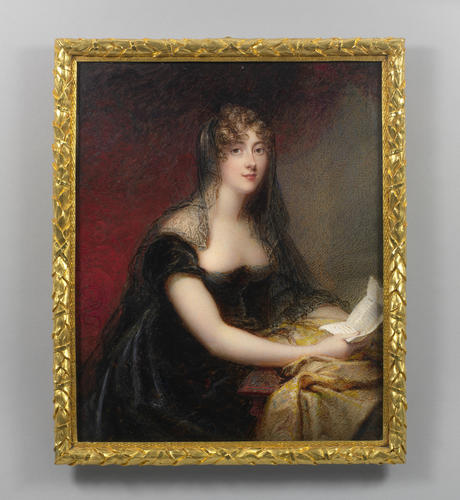-
1 of 253523 objects
Georgiana, Duchess of Devonshire (1757-1806) Inscribed 1813
Watercolour on ivory | 18.7 x 14.9 cm (sight) (sight) | RCIN 420819
-
Georgiana (1757-1806) was the eldest daughter of John Spencer, 1st Earl Spencer (1734–83), and his wife, Margaret Georgiana Spencer (1737–1814). The family travelled widely during Georgiana's childhood and entertained a variety of celebrated literary and political figures and, as a result, Georgiana developed a sophistication and charm. Horace Walpole, the art historian and writer, wrote: ‘her youth, figure, flowing good nature, sense and lively modesty, and modest familiarity, make her a phenomenon’. In 1774, she married the 5th Duke of Devonshire and soon became a fashion icon. She popularised the three-foot ostrich-feather headdress, extravagant hair towers and the free-flowing muslin dress that was simply tied by a ribbon around the waist. She also, however, became a heavy drinker and addicted to gambling, a lifestyle she came to regret. She wrote: ‘But my heart now feels an emptiness in the beau monde which cannot be filled … nobody can think how much I am tired sometimes with the dissipation I live in’. She became enthusiastically involved in politics and during the French invasion scare of 1778 she formed a female ‘battalion’ of leading Whig women, who dressed in the style of their husbands' regiments and accompanied the men to the military training camps. Her support for the Whig party in the Westminster election of 1786 brought accusations from the Morning Post that she was exchanging kisses for votes. She did finally stop gambling, but she was never able to pay off her debts. In her obituary, the Morning Chronicle wrote that she was ‘regarded as the glass and model of fashion, and amidst the homage which was paid to her, she moved with a simplicity that proved her to be unconscious of the charm which bound the world to her attraction’.
This portrait, painted seven years after the death of the Duchess, was based on an earlier miniature for which the artist had had a sitting in about 1800. It is one of the series of paintings in the ‘Gallery of Beauties’ commissioned by George IV when Prince Regent. These were portraits of fashionable ladies, one list of whom is in the Royal Archives and another printed in the Ladies Monthly Museum XVI (January 1814). A contemporary account records that the prince was ‘forming a superb boudoir for their reception’. Opulent frames for the paintings were ordered from Rundell, Bridge and Rundell in 1814. The series may have been conceived as a nineteenth-century version of the ‘Windsor Beauties’ painted by Sir Peter Lely for Anne Hyde, Duchess of York in 1662-5, and Sir Godfey Kneller’s ‘Hampton Court Beauties’ painted for Queen Mary around 1691.
Anne Mee (1780/5-1851) was the daughter of the artist John Foldsone. She was educated in London and was a protégée and pupil of the portrait painter George Romney. Lady Courtown introduced her to Queen Charlotte, and Charlotte Papendiek, journalist and assistant keeper of the wardrobe to Queen Charlotte, described Anne Mee drawing the queen and princesses at Windsor in 1790. Mee visited frequently after that date. Her portraits are often characterised by large eyes, and by 1804 she was able to ask as much as 40 guineas for a miniature.
The miniature is inscribed on the paper backing in ink: No 3 / Georgiana late / Duchess of Devonshire / painted by Anne Mee / 1813.Provenance
Painted for George IV when Prince of Wales
-
Medium and techniques
Watercolour on ivory
Measurements
18.7 x 14.9 cm (sight) (sight)
20.9 x 17.6 cm (frame, external)
